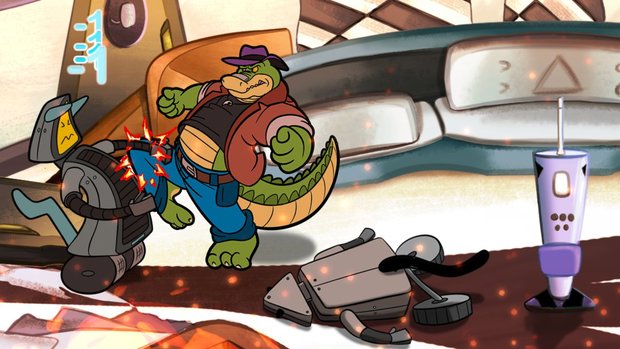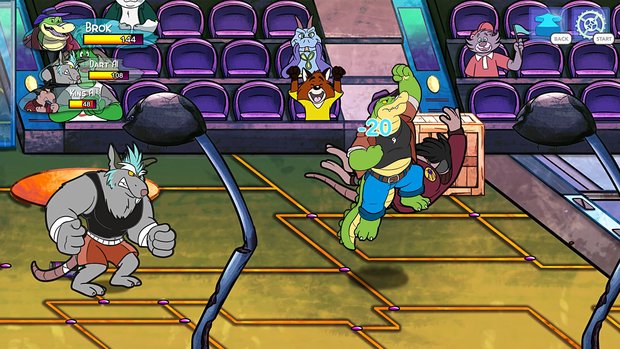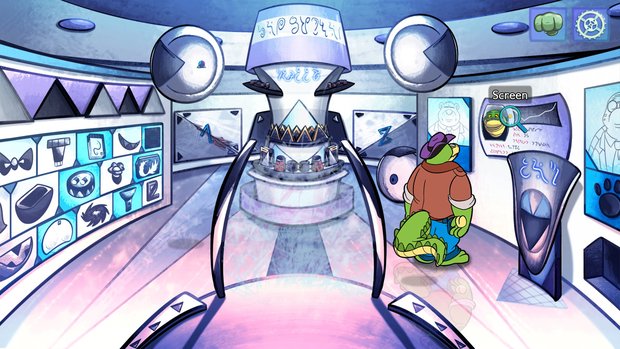BROK the InvestiGator review

- 0 Comments
A knockout blend of cartoon fighting and detective adventure
One of the first words that comes to mind about BROK the InvestiGator is ‘unique.’ It really is a one-of-a-kind game: partly a punch-em-up arcade game in the vein of Double Dragon, but also clearly an adventure game with a great detective story. Set in a futuristic segregated dystopia made up of Slumers and Drumers (those who live outside and inside the dividing hermetic dome, respectively) BROK’s is a world made up of anthropomorphic characters all extremely well-realised in an art style that brings to mind classic 90s cartoons like Teenage Mutant Ninja Turtles. But unlike those walking and talking reptiles, it’s not all puns and children’s entertainment here. Rather, it’s a story about the eponymous former boxing champion alligator and the P.I. jobs he takes to make a life for himself. A unique game indeed, but better than that, it’s a very fun game that’s well worth playing.
It’s not just any old detective story either. Within that familiar framework is another narrative that represents the true joy of BROK. This story is less about the society our scaly sleuth inhabits than it is about the relationship between Brok and his now-deceased-wife’s feline son, Graff, and how they grow closer together, or further apart, depending on the choices you make. And that relationship – the mystery surrounding why Brok’s wife died, his guilt over it, and his struggles to raise her son as part of the seemingly never-ending hopelessness of the Slumers – is the heart of what will keep you interested to the end. Before the credits roll, you’ll be fully invested and want to know how things turn out in whichever of the multiple endings you get.
The tale unfolds through a series of investigations Brok is tasked with solving. The first one you take on initially appears to be as simple as helping a police officer named Sin, a kangaroo, recover his lost gun. Sin claims to have come to you because the consequences would be dire for him if he went to the proper authorities, yet there seems to be something amiss, and you can’t quite put your finger on it. The investigation begins by visiting the locations where Sin lost the gun, looking for items that might reveal clues, and talking with (or beating on) people who might be able to help, neatly introducing many of the core gameplay elements.

This and all subsequent cases come down to a decision you must make based on the details uncovered during your investigation. You are able to look at a list of clues you have gathered, then click on two of them when confronting a suspect to combine them into one question. When you’re pursuing the possibility that Sin may be lying, for example, there are two conflicting pieces of information and putting them together reveals the truth. The final phase of a case usually comes down to a choice between two or three options, which in some cases is picking the correct person you believe has committed the crime.
The core of the game consists of this series of investigations, although some appear to be optional and not have any bearing on the main story. BROK is divided into six chapters, with a playtime of about 15 hours, so there’s lots of time to immerse yourself in this world. And there’s plenty of variety, as no two days are the same, whether you’re arcade-fighting your way through baddies, piecing together evidence, or solving puzzles that require you to move pieces into a correct order. The first day felt a bit slow and failed to hold my interest a couple of times, but the game gets better once it picks up momentum.
It’s important to pay attention as you play, because making the wrong choice could have repercussions later on. Finding the right criminal, deciding whether to believe someone or accuse them of lying, or any of the other decisions you make will affect other investigations down the track, even if it just means you have a better relationship with that person so they’re more willing to help you later on.
All this is well-written and captivating, but what really sets BROK apart is the ability to switch between adventure and action modes. While in the former, the gameplay is fairly standard point-and-click fare, with progress being made through the careful collection of items and information gained through exploration and conversation. Switching to action mode, it’s less about brains and more about brawn. Can’t get the suspect to give you the information you need? Change to action mode (simply by clicking an icon at the top-right of the screen) and beat the information out of him. Can’t open a door, just kick it in.

You’ll play the majority of the game as Brok, but occasionally you’ll switch to control Graff. Most puzzles have more than one solution, usually revolving around whether you turn to action mode or proceed with a more adventure-like solution. Early on, if you denounce someone as having committed a particular crime, they may turn on you and you’ll have to fight them, arcade-style. Yet it’s possible to avoid the fisticuffs by creating a drug that makes them more malleable to your interrogation. Graff’s decision to cheat on an assignment for school or not has major repercussions later on, and he can solve his problems either through thinking (adventure mode) or using his fists (arcade mode). In combat, Graff plays the same way as Brok but has different strengths and weaknesses; although he is faster, he has less health and is less able to withstand being hit than his stepfather.
When you’ve selected combat mode, you’re given the ability to punch, jump, and kick in real time using the action buttons on a control pad or the assigned keys on the keyboard. Your enemy, or multiple enemies at once, will advance towards you and strike when they are close enough, depleting your health. You can also punch, kick, and even use a special move, or you can defend yourself by either blocking their attack or jumping over some of their moves. Both you and your opponent(s) move at the same time, so it’s a matter of positioning yourself and doing the most damage. If you’re defeated, you’ll have to restore your game to an earlier point, whether your own manual saves or the latest autosave. It involves a different skillset than traditional adventure games – more dexterity and a certain amount of button mashing – but if it’s not your cup of tea, you do have the option to play the game with minimal fighting by selecting a lower difficulty level on startup.
In addition to the regular daily investigations, in the evenings Brok is able to participate in the Virtual Arena, fighting to make some extra money. It’s really just a thinly veiled attempt to provide more opportunity to play a punch-em-up game (you’ll never actually use the money), but it does fit in well with Brok’s backstory as a professional boxer, and it’s a fun little diversion. It also allows the player to level up their characters without advancing the story line, making later combat encounters easier.

While the investigations are enjoyable to play, whether as a puncher or private eye, the pieces of story that seem to be less important are what bring this game alive even more. That’s because Brok is still trying to deal with his wife’s death five years earlier. Some of his memories seem to be missing, and he’s having terrible dreams about the night she died. Her son Graff is now withdrawn, angry, and tries to isolate himself completely when Brok attempts to comfort him. This overarching story of how Brok’s wife died and why proves to be even more interesting than the detective cases themselves.
The pieces of Brok’s family life come slowly at first, creating drama between the two characters that really lands by the time it is resolved. I mentioned that choices matter in BROK, and nowhere is that more true than the decisions Brok and Graff make towards each other that will determine if the final outcome is a good one or not. And when it comes to endings, this game doesn’t disappoint, with multiple endings that range from the canonical one that I assume will lead to a sequel, to a fairly balanced one that leaves several issues unresolved, to another outcome that is just plain depressing. No single choice you make seems to determine the result, but rather how you’ve played the entire game and what paths you’ve taken.
For the most part BROK plays out like a classic point-and-click, with a mouse cursor that changes to the appropriate function over hotspots and guides the current protagonist around the screen (double-clicking to run). To change locations, you simply move the cursor to the edge of the screen and click the exit icon; there is a map for instantly transporting between the major locations. Conversations activate a radial wheel of dialog options, as well as the choice to offer or use an inventory item. Another useful feature is the option to think, which gives a subtle clue about your current situation. This is just a very basic reminder of conversations and clues you’ve found, but there is also a full help feature accessed by collecting specific items that can be spent to purchase a more direct hint. The number and general locations of these items can be seen in the options menu, which is also where you can purchase the hints themselves.

Manually switching, or being forcibly switched (which is rare but does happen depending on the initial difficulty you’ve selected) to action mode changes the control scheme to match the new style of play, and using my gamepad felt more intuitive for fighting. The problem is that the adventure game parts are more tedious that way, moving your character using the left analog stick with interactive areas highlighting as you move through them. If you have both, you can change between the mouse and gamepad when circumstances call for it, but it feels rather clumsy doing so. I did appreciate, however, that you can remap the controls on whatever device you use.
There is an atmosphere-building piano-synth soundtrack playing in most scenes, although there doesn’t seem to be much differentiation between areas. The one exception is when switching to arcade mode, when the music becomes more decidedly upbeat. While the sound effects in adventure mode are fine, the ones in arcade mode are really fun, with every kick, jump, and punch making a sound, while Brok and Graff both make puffed grunts when they strike and pain sounds when they are hit. It’s entertaining and really sells the arcade feel.
There is nothing about the cartoon artwork in BROK that I don’t love. City streets in the rundown Slumer district are filled with cracked walls and broken doors, junk scattered all over the ground, with paint and posters peeling from the walls. The dilapidated walls and floor, broken appliances, and rough edges in the hallway directly outside Brok’s apartment set the scene early on that he isn’t rich or powerful, just a working alligator trying to get by in a harsh world. This is juxtaposed against the modern, sleek areas like the Consciousness Center where Graff studies, its beautiful glass windows looking out at the clean, inspiring domed city off in the distance. And when you venture into the city itself, you’ll find more of the same crisp, sharp aesthetic – the opposite of where Brok spends most of his days.
The game isn’t just good-looking, as its world is filled with interesting and well-developed characters. Shay, a buzzard, is Brok’s best friend who harbours a secret about Brok that is revealed in one of the endings. She is a brilliant yet eccentric inventor whose character arc and story play a key role in the climax of the game. The female robot director of the Consciousness Center not only teaches Graff and the other students, she also plays a significant role in one of the outcomes. These characters and more, all comprising different animal species, add to the narrative depth and successfully bring together a large but interconnected world in a personal way.
Everyone you speak to has their own well-drawn and animated dialog portrait, but the ones for Brok and Graff stand out the most, with many facial expressions such as anger, disgust, joy, and surprise shown to help convey emotion. In-game the animations are smooth and the characters fit beautifully into every background, and there is a wonderful fluidity to the way they transition from adventure to arcade modes. Instead of just standing in a static pose, they crouch down a little into a classic boxer’s stance, bobbing slightly side to side as they wait for your attack. It’s all done so smoothly that there’s no discernible change for Brok, so you can start moving, punching and kicking right away, with each combat move animated nicely.
Better still, each character is exceptionally well-cast, no matter how secondary, the voice work perfectly suited to their respective designs. Two of particular note are the main antagonist for Graff, a fellow student named Klay (a mountain lion), and the dingo Dee, one of Brok’s main fighting opponents in the arena most nights who goes on to greatly help in solving his main investigation.
Final Verdict
BROK the InvestiGator is something that hasn’t been done before, combining a punch-em-up arcade game with a traditional point-and-click adventure game. It may not sound like an obvious match, but the mashup of these two seemingly opposite genres is a thoroughly entertaining experience. You don’t have to fight if you’d rather not, which is a welcome option for those who’d prefer a more pacifistic approach, but you’ll be missing out if you don’t at least give it a try. The dystopian worlds inhabited by anthropomorphic animals might not seem to be the most natural setting for a deep or meaningful story either, but with interesting main characters, plenty of family drama, and a wonderfully acted supporting cast all realised in a 90s Saturday morning cartoon style, you’ll find that BROK packs quite the punch, in more ways than one.
Hot take
With a surprisingly deep story set in a dystopian world of diverse animal cartoon characters, BROK the InvestiGator successfully melds the arcade and adventure genres in a unique and extremely enjoyable way.
Pros
- Layered story that isn’t afraid to explore character emotions
- Distinctive and well-realised cast characters
- Beautiful art style brings to mind the joy of 90s Saturday morning cartoons
- Great voice acting complemented by animated portraits during conversation
Cons
- The two different game modes are best suited to different control methods
- A bit more musical variety would have been welcome











0 Comments
Want to join the discussion? Leave a comment as guest, sign in or register.
Leave a comment